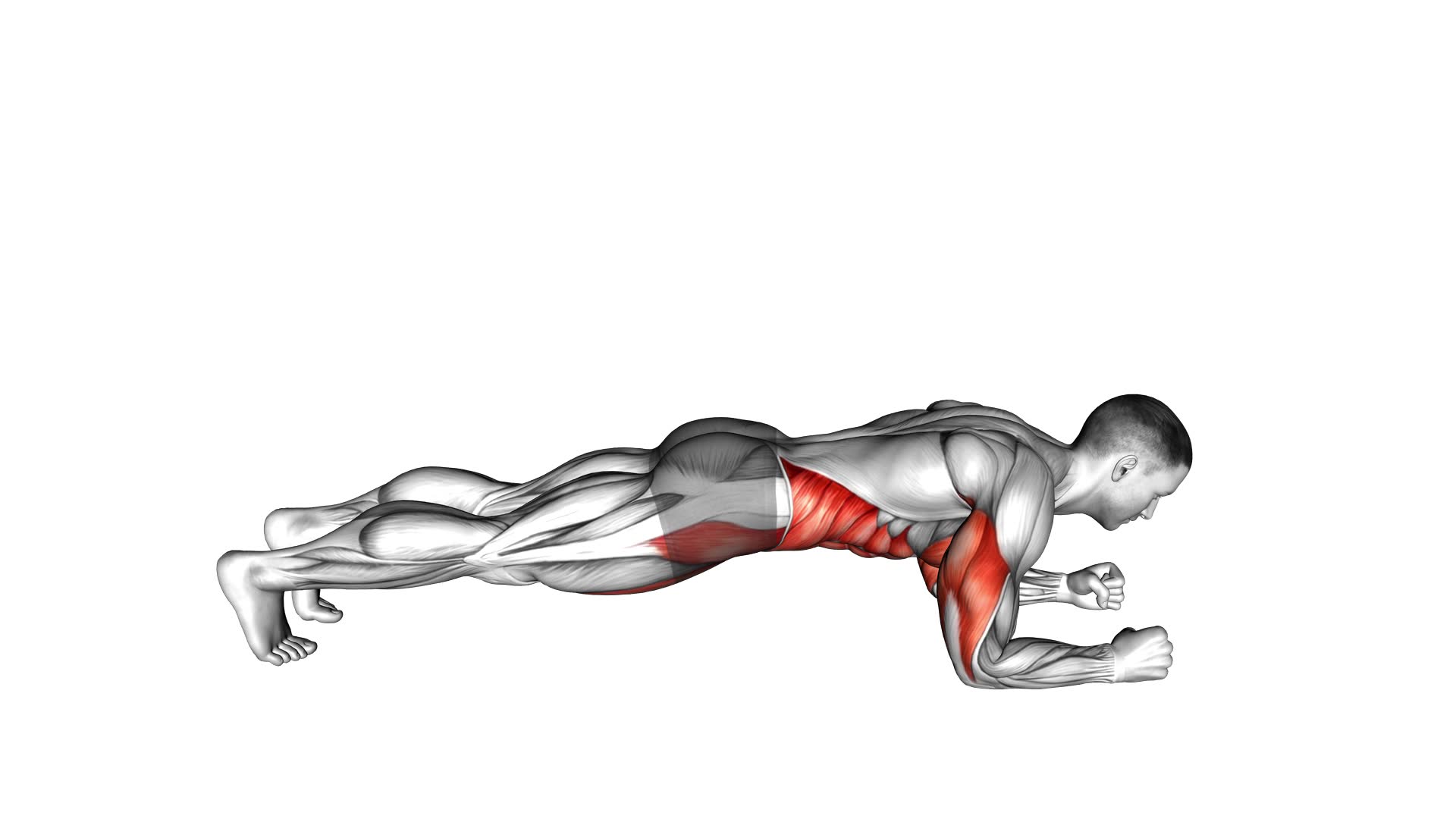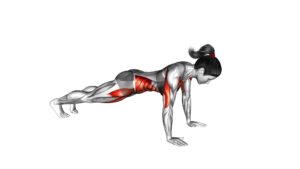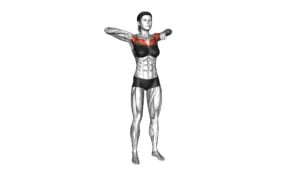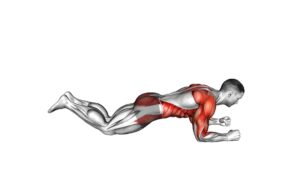Elbow-Up and Down Dynamic Plank – Video Exercise Guide & Tips

Looking to strengthen your core and increase overall stability? The Elbow-Up and Down Dynamic Plank is the perfect exercise for you.
Watch This Exercise Video
This video exercise guide will walk you through the proper form and technique, as well as provide helpful tips to maximize your workout.
Don't miss out on the benefits of this challenging plank variation. Get ready to feel the burn and take your fitness to the next level.
Let's get started!
Key Takeaways
- Enhances core strength and stability
- Improves muscle activation
- Promotes proper breathing techniques
- Increases upper body strength
Benefits of the Elbow-Up and Down Dynamic Plank
Experience enhanced core strength and stability by incorporating the Elbow-Up and Down Dynamic Plank into your fitness routine. This exercise offers numerous benefits, including improved muscle activation and proper breathing techniques.
When performing the Elbow-Up and Down Dynamic Plank, you engage your core muscles, including the rectus abdominis, transverse abdominis, and obliques. These muscles work together to stabilize your spine and pelvis, helping you maintain proper form and alignment. This exercise also activates the muscles in your shoulders, chest, and arms, further enhancing your upper body strength.
In addition to muscle activation, the Elbow-Up and Down Dynamic Plank promotes proper breathing. As you hold the plank position, focus on taking deep breaths, inhaling through your nose and exhaling through your mouth. This controlled breathing pattern helps oxygenate your muscles and improves your overall performance.
Proper Form and Technique for the Exercise
To ensure proper form and technique for the Elbow-Up and Down Dynamic Plank, it's important to maintain a strong and stable core throughout the exercise. Here are some key tips to help you achieve optimal core stability and muscle activation:
- Start in a plank position on your forearms, with your elbows directly under your shoulders and your body in a straight line from head to toe.
- Engage your core by pulling your belly button towards your spine and squeezing your glutes.
- Slowly lift one elbow off the ground and place your hand where your elbow was, while maintaining a straight line from head to toe.
- Repeat the movement with the opposite arm, alternating between lifting and lowering the elbows.
By maintaining a strong and stable core, you ensure that your body stays aligned and your muscles are properly engaged throughout the exercise. This promotes better muscle activation and helps to prevent injury.
Now that you know how to perform the Elbow-Up and Down Dynamic Plank with proper form and technique, let's move on to the next section where we'll discuss common mistakes to avoid during the exercise.
Common Mistakes to Avoid During the Elbow-Up and Down Dynamic Plank
To perform the Elbow-Up and Down Dynamic Plank correctly, it's important to maintain proper form throughout the exercise.
Keep your core engaged by tightening your abdominal muscles and glutes.
Remember to control your breath, inhaling deeply as you lift your body and exhaling as you lower it.
Proper Form Importance
Maintaining proper form is crucial for performing the Elbow-Up and Down Dynamic Plank correctly and maximizing its benefits. Here are some common mistakes to avoid in order to ensure proper core stability and body alignment:
- Dropping the hips: Keep your hips in line with your shoulders and avoid letting them sag or drop. This helps engage your core muscles effectively.
- Arching the back: Maintain a neutral spine by engaging your core and keeping your back straight. Avoid excessive arching or rounding of the back, as this can lead to strain or injury.
- Raising the shoulders: Keep your shoulders relaxed and away from your ears. Avoid shrugging or lifting them excessively, as this can cause tension in the neck and shoulders.
- Holding your breath: Remember to breathe throughout the exercise. Inhale deeply and exhale as you move between the elbow-up and down positions.
Core Engagement Tips
Avoid these common mistakes to ensure proper core engagement during the Elbow-Up and Down Dynamic Plank.
Core activation is key to maximizing the effectiveness of this exercise. One mistake to avoid is letting your lower back sag or arch during the plank. This not only takes the focus away from your core, but it also puts unnecessary strain on your lower back.
Another mistake isn't engaging your glutes and squeezing your core muscles. Without this activation, you won't be able to maintain proper form and stability during the exercise.
Additionally, be mindful of your shoulder positioning. Keep your shoulders directly above your elbows to avoid placing excessive stress on your shoulder joints.
Breath Control Techniques
Are you breathing correctly while performing the Elbow-Up and Down Dynamic Plank? Proper breath control is essential for maximizing the effectiveness of this exercise and preventing potential injuries. Here are some breathing techniques and relaxation methods to help you maintain control and stability throughout the movement:
- Inhale deeply through your nose as you lower your body towards the ground.
- Exhale forcefully through your mouth as you push back up into the starting position.
- Focus on exhaling fully to engage your core muscles and maintain stability.
- Practice diaphragmatic breathing, allowing your belly to rise and fall with each breath, to promote relaxation and reduce tension in your body.
Variations and Progressions for a Greater Challenge
To increase the difficulty of the Elbow-Up and Down Dynamic Plank exercise, you can try various variations and progressions.
These modifications will challenge your core and upper body strength even further.
One variation you can attempt is the Single Leg Elbow-Up and Down Dynamic Plank. This involves performing the exercise with only one leg lifted off the ground, which increases the instability and requires greater core engagement.
Another variation is the Elbow-Up and Down Dynamic Plank with Knee Tucks. In this progression, you perform the plank as usual, but also bring your knees towards your chest one at a time, targeting your abs and hip flexors.
Additionally, you can try the Elbow-Up and Down Dynamic Plank with Shoulder Taps. Instead of lifting your leg or tucking your knees, you touch each shoulder with the opposite hand while maintaining the plank position. This variation challenges your core stability and shoulder strength.
Remember to maintain proper form and control throughout these variations and progressions to maximize their effectiveness.
Tips for Getting the Most Out of Your Elbow-Up and Down Dynamic Plank
To get the most out of your Elbow-Up and Down Dynamic Plank, it's important to focus on proper form techniques.
Make sure that your elbows are directly under your shoulders and that your body forms a straight line from head to toe.
Engage your core muscles and avoid sagging or lifting your hips.
Additionally, work on increasing your plank endurance by gradually increasing the amount of time you hold the plank position.
Proper Form Techniques
Get the most out of your Elbow-Up and Down Dynamic Plank by focusing on proper form techniques. Here are some tips to help you maximize your core stability and muscle activation during this exercise:
- Start in a high plank position with your hands directly under your shoulders and your body in a straight line from head to toe.
- Engage your core by drawing your belly button in towards your spine and squeezing your glutes.
- Lower down onto your forearms one arm at a time, keeping your elbows directly under your shoulders.
- Push back up onto your hands one arm at a time, maintaining a strong and stable core throughout the movement.
Increasing Plank Endurance
To increase your plank endurance and get the most out of your Elbow-Up and Down Dynamic Plank, focus on maintaining proper form and engaging your core muscles throughout the exercise.
Plank variations are a great way to challenge and strengthen your core muscles, which will help improve your endurance. Start by mastering the basic plank position, ensuring that your body is in a straight line from head to toe.
As you progress, you can try different variations such as side planks, plank jacks, and plank with leg lifts. These variations target different areas of your core and provide a more challenging workout.
Remember to breathe deeply and engage your core muscles by pulling your belly button towards your spine.
Frequently Asked Questions About the Elbow-Up and Down Dynamic Plank
For a clearer understanding of the Elbow-Up and Down Dynamic Plank, here are some frequently asked questions answered:
- How does the Elbow-Up and Down Dynamic Plank activate the core?
- The Elbow-Up and Down Dynamic Plank is a challenging exercise that targets the core muscles, including the rectus abdominis, transverse abdominis, and obliques. By moving the elbows up and down, you engage the entire core, helping to strengthen and stabilize the abdominal muscles.
- Can the Elbow-Up and Down Dynamic Plank be modified for beginners?
- Yes, the Elbow-Up and Down Dynamic Plank can be modified for beginners. Start by holding the plank position on your forearms and knees instead of your toes. Gradually progress to performing the exercise on your forearms and toes as you build strength and stability.
- What other plank modifications can I try?
- If you're looking for plank modifications, you can try variations like side planks, plank with leg lifts, or plank with shoulder taps. These exercises target different muscle groups while still engaging the core, providing a variety of challenges and helping you progress in your fitness journey.
- How often should I incorporate the Elbow-Up and Down Dynamic Plank into my workout routine?
- It's recommended to incorporate the Elbow-Up and Down Dynamic Plank into your workout routine 2-3 times a week. Remember to listen to your body and gradually increase the intensity and duration of the exercise to avoid overexertion or injury.
Frequently Asked Questions
How Long Should I Hold the Elbow-Up and Down Dynamic Plank?
To get the most out of the elbow-up and down dynamic plank, it's important to focus on proper form and technique.
The duration of the exercise will vary depending on your fitness level and goals. As you become more advanced, you can gradually increase the length of time you hold the plank.
Remember, the benefits of this exercise include strengthening your core, improving stability, and engaging multiple muscle groups.
Don't be afraid to try different variations to keep challenging yourself.
Can I Do This Exercise if I Have Wrist Pain or Injury?
If you're experiencing wrist pain or have an injury, it's best to modify the Elbow-Up and Down Dynamic Plank exercise. There are alternative exercises you can do that won't put strain on your wrists.
It's important to listen to your body and avoid any exercises that cause discomfort.
Consult with a fitness professional or physical therapist for specific modifications that suit your individual needs.
Is It Normal to Feel Discomfort in My Shoulders and Core While Performing This Exercise?
Feeling discomfort in your shoulders and core during this exercise isn't unusual. Planks can put a lot of pressure on these areas.
However, if the discomfort is severe or persistent, it may be a sign of improper form or an underlying issue. Remember to engage your core and maintain proper alignment.
If the exercise is too challenging, you can modify it by starting on your knees or reducing the range of motion.
Should I Incorporate This Exercise Into My Routine if I Am a Beginner?
If you're a beginner, it's important to consider the proper form in the elbow up and down dynamic plank. This exercise can provide numerous benefits when incorporated into your routine. It helps strengthen your core, shoulders, and overall stability.
However, before adding it to your workout, make sure you have a solid foundation and understand the correct technique. Starting with simpler plank variations may be a better option to build strength before attempting this more advanced exercise.
Can I Modify the Elbow-Up and Down Dynamic Plank if I Find It Too Challenging?
If you find the elbow-up and down dynamic plank too challenging, don't worry! There are modifications and alternative exercises you can try.
For example, you can start by holding a static plank position on your elbows or knees instead. This will help build your strength and stability before attempting the dynamic version.
Conclusion
In conclusion, the elbow-up and down dynamic plank is a highly effective exercise that targets the core muscles and improves stability. By maintaining proper form and avoiding common mistakes, you can maximize the benefits of this exercise.
Additionally, incorporating variations and progressions can provide a greater challenge and enhance your overall strength and endurance. Remember to follow the provided tips to get the most out of your elbow-up and down dynamic plank.

Author
Years ago, the spark of my life’s passion ignited in my mind the moment I stepped into the local gym for the first time. The inaugural bead of perspiration, the initial endeavor, the very first surge of endorphins, and a sense of pride that washed over me post-workout marked the beginning of my deep-seated interest in strength sports, fitness, and sports nutrition. This very curiosity blossomed rapidly into a profound fascination, propelling me to earn a Master’s degree in Physical Education from the Academy of Physical Education in Krakow, followed by a Sports Manager diploma from the Jagiellonian University. My journey of growth led me to gain more specialized qualifications, such as being a certified personal trainer with a focus on sports dietetics, a lifeguard, and an instructor for wellness and corrective gymnastics. Theoretical knowledge paired seamlessly with practical experience, reinforcing my belief that the transformation of individuals under my guidance was also a reflection of my personal growth. This belief holds true even today. Each day, I strive to push the boundaries and explore new realms. These realms gently elevate me to greater heights. The unique combination of passion for my field and the continuous quest for growth fuels my drive to break new ground.



